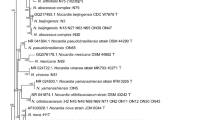Abstract
Clinical isolates of Nocardia brasiliensis from Japan were classified into two groups based on their susceptibility to the carbapenem antibiotic, imipenem (IPM). Of 33 strains tested, 10 belonged to an IPM susceptible group, with MIC of from 0.25 to 2 εg/ml and a MIC80 value of 1.5 εg/ml for this antibiotic. The remaining 23 strains belonged to an IPMresistant group with MIC and MIC80 values of 8–16 εg/ml and >16 εg/ml, respectively. The type strain of N. brasiliensis belonged to this resistant group. Analysis of 16S rDNA genes sequences showed that the IPM susceptible group had characteristic single nucleotide substitutions at positions 103 (T), 381 (A), and 456 (A), in contrast to the IPM resistant group. This grouping, however, was not associated with their clinical manifestation.
Similar content being viewed by others
References
Kiska D, Hicks K, Pettit DJ. Identification of medically relevant Nocardia species with an abbreviated battery of tests. J Clin Microbiol 2002; 40: 1346–1351.
Hamid ME, Maldonado L, Eldin GS, Mohamed MF, Saeed NS, Goodfellow M. Nocardia africana sp. nov., a new pathogen isolated from patients with pulmonary infections. J Clin Microbiol 2001; 39: 625–630.
McNeil MM, Brown JM. The medically important aerobic actinomycetes: epidemiology and microbiology. Clin Microbiol Rev 1994; 7: 357–417.
Wallace RJ, Brown BA, Blacklock Z, Ulrich R, Jost K, Brown JM, NcNeil MM, Onyi G, Steingrube VA, Gibson J. New Nocardia taxon among isolates of Nocardia of Nocardia pseudobrasiliensis associated with invasive diseases. J Clin Microbiol 1995; 33: 1528–2533.
Ruimy R, Riegel P, Carlotti A, Boiron P, Bernardin G, Monteil H, Wallace R J Jr, Charisten R. Nocardia pseudobrasiliensis sp. nov., a new species of Nocardia which groups bacterial strains previously identified as Nocardia brasiliensis and associated with invasive diseases. Int J Syst Bacteriol 1996; 24: 54–63.
Mikami Y, Yazawa K. Susceptibility patterns of pathogenic Nocardia to some selected antimicrobial agents and their usefulness in the identification work. Bull of JFCC 1989; 5: 89–95.
Gordon RE, Barnet DA, Handerhan JE, Pang CH. Nocardia coelica, Nocardia autotrophica, and the Nocardia strain. Int J Syt Bacteriol 1974; 24: 54–63.
Staneck JL, Roberts GD. Simplified approach to identification of aerobic actinomycetes by thin-layer chromatography. J Appl Microbiol 1974; 28: 226–231.
Lechevalier MP, Lechevalier HA. Chemical composition as a criterion in the classification of aerobic actinomycetes. Int J Syst Evol Microbiol 1970; 20: 435–443.
Minnikin DE, Hutchison IG, Caldicott AB, and Goodfellow M. Thin-layer chromatography of methanolysates of mycolic acid-containing bacteria. J Chromatography 1980; 188: 221–233.
Chun J, Goodfellow M. A phylogenetic analysis of genus Nocardia with 16S rRNA gene sequences. Int J Syst Bacteriol 1955; 45: 240–245.
Tamura M, Watanabe K, Mikami Y, Yazawa K, Nishiumura K. Molecular characterization of new clinical isolates of Candida albicans and C. dubliniensis in Japan: Analysis reveals a new genotype of C. albicans with group 1 intron. J Clin Microbiol 2001; 39: 4309–4315.
Saitou N, Nei M. The neighbor-joining method: a new method for reconstructing phylogenetic trees. Mol Biol Evol 1987; 4: 406–425.
Thompson JD, Higgins DG, Gibson TJ. CLUSTAL W: Improving the sensitivity of progressive multiple sequence alignment through sequence weighting, position specific gap penalties and weight matrix choice. Nucleic Acids Res 1994; 22: 4673–4680.
Wilson RW, Steingrube VA, Brown BA, Blacklock Z, Jost Jr. KC, Mcnabb A, Colby WD, Biehle JR, Gibson JL, Wallace Jr. RJ. Recognition of a Nocardia transvalensis complex by resistance to aminoglycosides, including amikacin, and PCR-restriction fragment length polymorphism analysis. J Clin Microbiol 1997; 35: 2235–2242.
Pournaras S, Maniati M, Petinaki E, Tzouvelekis LS, Tsakris A, Legakis NJ, Maniatis AN. Hospital outbreak o multiple clones of Pseudomonas aeruginosa carrying the unrelated meatlo-β-lactamase gene variants blaVIM-2 and blaVIM-4. J Antimicrob Chemother 51: 1409–1414.
Mercuri PS, Ishii Y, Ma L Rossolini GM, Luzzaro F, Amicosante G, Franceschini N, Galleni M. Clonal diversity and metallo-β-lactamase production in clinical isolates of Stenotrophomonas maltophila. Microb Drug Resist 2002; 193–200.
Fitch WM, Margoliash E. Construction of phylogenetic trees: a method based on mutation distances as estimated from cytochrome c sequences is of general applicability. Science 1967; 155: 279–284.
Author information
Authors and Affiliations
Corresponding author
Rights and permissions
About this article
Cite this article
Kageyama, A., Hoshino, Y., Watanabe, M. et al. Clinical isolates of Nocardia brasiliensis from Japan exhibit variable susceptibility to the antibiotic imipenem. Mycopathologia 158, 275–278 (2004). https://doi.org/10.1007/s11046-005-4487-z
Received:
Accepted:
Issue Date:
DOI: https://doi.org/10.1007/s11046-005-4487-z




